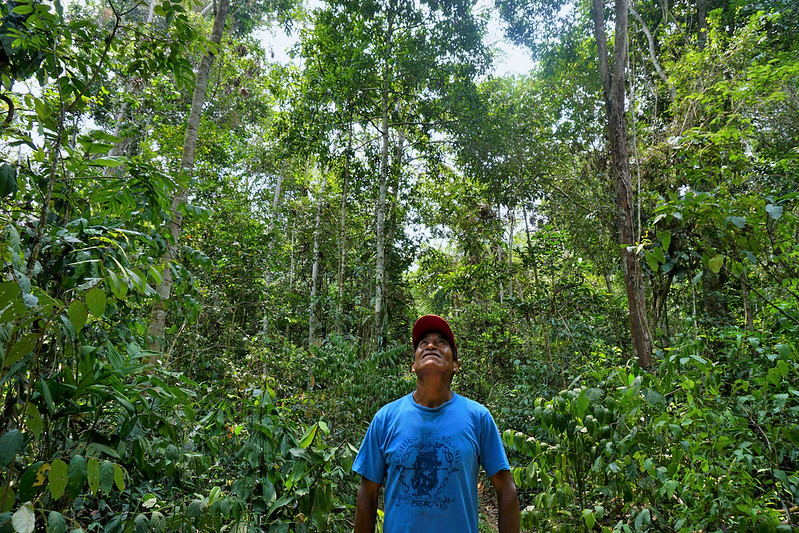For decades, the Yaigojé Apaporis Indigenous People in Colombia’s lower Apaporis River Basin worked to get their traditional lands formally recognized by the government and secured from outside threats. Initially protected as the Yaigojé Apaporis Reserve, it was also declared an Indigenous territory in 1988.
But in 2007, Cosigo Resources, a Canadian mining company, requested from the government a gold mining concession within the Yaigojé Apaporis Reserve. The Yaigojé Apaporis were alarmed, but unlike other Indigenous groups around the world, they had some legal options. Laws in Colombia recognize Indigenous Peoples’ right of consultation, although not consent. They also provide Indigenous communities with the right of first refusal, meaning they are first offered the mineral rights before the government can grant a mining concession to a third party. And while national laws allow mining on Indigenous lands, it is not permitted in national parks.
The Yaigojé Apaporis responded to this threat by asking the government to establish their reserve as a national park and, in 2009, the Yaigojé Apaporis National Natural Park was created. The national authority and Yaigojé Apaporis leaders agreed on joint coordination for the use and monitoring of the parkland and resources.
Regrettably, two days after the park’s creation, the government mining authority granted a concession to Cosigo anyway. While it was quickly cancelled, Cosigo sued the government. Colombia’s courts ruled in favor of the Yaigojé Apaporis, but the matter is now pending international arbitration.
The Struggle for Land Rights Is Prevalent Throughout the Amazon
New WRI research documenting the experiences of Indigenous Peoples in several Amazon countries found that the Yaigojé Apaporis people’s story is all too familiar.
Our research found that large-scale mining concessions cover over 18% of the Amazon (approximately 1.28 million square kilometers – 494,000 square miles – excluding French Guiana). These mining concessions, together with illegal mining areas, overlap with more than 20% of Indigenous land, threatening the livelihoods and well-being of many Indigenous Peoples.
And it’s a problem that’s poised to worsen. Approximately 143,000 square kilometers (55,000 square miles) of Indigenous land overlaps with active mining concessions (concessions in which exploration or exploitation are underway) and known illegal mining areas — much of it in Venezuela, Brazil and Colombia. The remaining 302,000 square kilometers (117,000 square miles) of Indigenous land overlaps with concessions that have been demarcated but not allocated or where mining operations have not yet started. With prices of gold and other minerals surging in the wake of the COVID-19 pandemic, exploration and exploitation may soon spread.
Explore the interactive map above to see where legal and illegal mining sites overlap with indigenous territories. Click on the arrows to expand the legend.
The Problem with Mining in Indigenous Lands
Many Indigenous Peoples take extraordinary measures to protect their lands from mining by outsiders. Some measures are successful, but many are not. And too often, Indigenous Peoples pay high prices for their efforts. Global Witness reported a record 212 land and environmental defenders murdered in 2019, including many Indigenous People. Over two-thirds of these killings occurred in Latin America, and mining continues to be the deadliest sector.
Our research found that Indigenous lands with mining activities had a higher incidence of forest loss than those without mining across the Amazon. In Bolivia, Ecuador and Peru, for example, forest loss was at least three times higher on Indigenous lands with mining than those without from 2000-2015. In Colombia and Venezuela, it was one to two times higher.
This is a problem for forests and for Indigenous groups. Land, together with its natural resources and ecosystem services, is the source of livelihood and well-being for most Indigenous Peoples. This land delivers food, water, fuelwood, medicinal plants and other critical resources, while also providing communities with security, status, social identity and a safety net. For many Indigenous Peoples, land is also historically, culturally and spiritually significant.

A Kichwa woman in Orellana, Ecuador. Photo by Tomas Munita/CIFOR
Laws Do Not Adequately Protect Indigenous Lands
The laws in Bolivia, Brazil, Colombia, Ecuador, Guyana and Peru – six countries that contain more than 90% of the Amazon Basin – provide Indigenous People with some land rights, such as the rights to use certain natural resources on their lands for domestic or subsistence purposes, and to exclude illegal outsiders. But these governments recognize few Indigenous rights to the minerals on or under their land. Indigenous People in all six countries have the right of consultation before mining concessions are granted, but only in Guyana do they have the right to consent – although limited. And only in Colombia do Indigenous People have the right of first refusal if the government wants to grant commercial mineral rights on Indigenous land. Many Indigenous People in the Amazon, however, do not want their lands mined for commercial purposes.
Mining companies with legal minerals rights have significant powers to enter and use Indigenous land for their operations. In Colombia and Guyana, the government can also establish an easement on Indigenous land to enable miners to develop their activities. Only in Brazil is mining on Indigenous lands illegal, although there are several proposals in Congress, with support of the current administration, to open this land up to mining and other development.
As our research shows, however, in practice, governments often fall short of effectively enforcing the laws. As a consequence, miners often operate illegally without penalty.

Mining site in La Lampa, Madre de Dios, Peru.
Addressing the Large Power Discrepancies Between Indigenous Peoples and Miners
Based on the research findings, we make five recommendations designed to secure Indigenous land and empower Indigenous People to take charge of their own development. The report calls for:
- Amazonian governments to enact legislation that recognizes broad sets of land and natural resource rights for Indigenous Peoples, as well as the right of free, prior and informed consent and the right of first refusal. For example, while Indigenous Peoples in the Amazon have rights to access and occupy their territories, very few have the right to manage their land and natural resources, withdraw natural resources for commercial purposes without special permission, transfer their land rights to another entity or refuse to let companies with mineral rights access their land.
- Governments to establish strong social and environmental safeguards for mining that are consistent with international standards, and to be more selective in the allocation of mining concessions. For example, governments should only consider companies that use the latest technologies to minimize environmental impacts and that possess strong track records of meeting or exceeding safeguards, especially those that require meaningful engagement with Indigenous Peoples before mining begins.
- Mining companies to recognize and respect the rights of Indigenous Peoples. This includes recognizing formally recognized and titled lands, as well as Indigenous lands held only under customary tenure arrangements. Companies must also negotiate fair agreements with Indigenous communities, providing benefit-sharing packages that address community interests and strengthen local capacity for self-determined development.
- Indigenous Peoples to build the skills needed to effectively address the challenges from mining. Some groups have successfully used new technologies to collect data on illegal activities that meet the legal burden of proof and can be used in courts of law. Others have better protected themselves from harm by learning new approaches to deescalating confrontational situations or self-defense techniques.
- Amazonian governments to strengthen their oversight of mining on Indigenous lands to ensure strict compliance with national laws and the provisions of license and concession agreements. Government efforts should not be limited to capturing and prosecuting illegal miners on Indigenous lands. They should also target the individuals who hire, finance or otherwise facilitate illegal mining. Those who sell and profit from the illicit trade in gold, diamonds and other minerals must also be identified and prosecuted.
LEARN MORE: Read the full report, Undermining Rights: Indigenous Lands and Mining in the Amazon.



